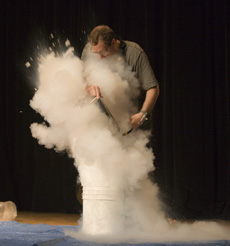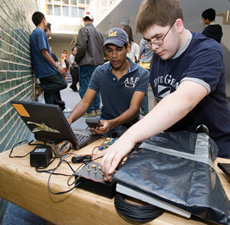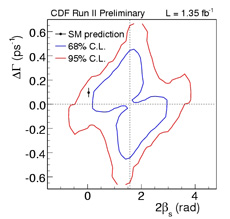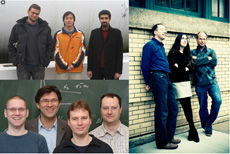|
Thursday, Jan. 17
1 p.m.
Physics and Detector Seminar - West Wing, WH-10NW
Speaker: W. Morse, Brookhaven National Laboratory
Title: The Far Forward Region of ILC Detectors
2:30 p.m.
Theoretical Physics Seminar - Curia II
Speaker: J. Shu, University of Chicago
Title: Top Compositeness at the Tevatron and LHC
3:30 p.m.
DIRECTOR'S COFFEE BREAK - 2nd Flr X-Over
THERE WILL BE NO ACCELERATOR PHYSICS AND TECHNOLOGY SEMINAR TODAY
Friday, Jan. 18
3:30 p.m.
DIRECTOR'S COFFEE BREAK - 2nd Flr X-Over
4 p.m.
Joint Experimental-Theoretical Physics Seminar - One West
Speaker: C. Leonidopoulos, CERN
Title: The LHC Trigger Challenge and the CMS Strategy
8 p.m.
Fermilab Lecture Series - Auditorium
Tickets: $5
Speaker: Chris Quigg
Title: The Coming Revolutions in Particle Physics
Click here for NALCAL,
a weekly calendar with links to additional information.
|
Thursday, Jan. 17
- Tomato Florentine
- *Grilled chicken cordon bleu sandwich
- Chimichangas
- Smart cuisine: chicken marsala
- Smoked turkey melt
- Assorted slice pizza
- SW chicken salad w/roasted corn salsa
*Carb restricted alternative
Wilson Hall Cafe menu |
|
Thursday, Jan. 17
Dinner
- Closed
Wednesday, Jan. 23
Lunch
- Tinga Con tostadas
- Rice & beans
- Pico de gallo
- Pastel de tres leche
Chez Leon menu
Call x4598 to make your reservation. |
|
|
Discoveries for all ages at Fermilab open house

Jerry Zimmerman, Mr. Freeze, conducts a demonstration during his show. The cryogenics show will be part of this year's Open House on Jan. 27.
Fermilab makes scientific discoveries that expand the limits of knowledge of the universe.
But on Jan. 27, not just physicists will be making discoveries at the laboratory. At Fermilab's Family Open House, children and their parents can learn about basic physics, through nearly half-a-dozen hands-on activities and demonstrations, all while immersed in the nation's premier physics laboratory.
Would-be scientists can enjoy the challenge of games, such as the gravity accelerator that dares a child to race the machine faster than a ball can spiral through a tube.
"They come back every year," said Karen Bass, a retired Naperville teacher and Fermilab education docent involved in the Open House planning. "They say, 'I'm a grade older. Maybe I can beat that ball this year.' Very rarely do they beat it."
Children, and adults, can learn the science behind pulling a table cloth out from under bottles of water, turning white light into a rainbow of colors and passing an electric wire over a bent wire in the carnival skill test reminiscent of the game Operation.
Each activity is its own experiment, entertaining while teaching the premises of magnets, propulsion, gravity and atomic structures.
"They are all fun," Bass said. "I can't think of any of them I don't like."
The famous Mr. Freeze will also conduct his cryogenics show, demonstrating how below-zero temperatures shatter gloves, create rocket-like propulsion and deflate balloons.
The event draws about 2,000 annually. Due to increased community interest generated by news stories about federal science budget cuts, Fermilab is opening its doors to more visitors and eliminating registration this year.
Tours will encompass Wilson Hall and the linear accelerator, where particles get their boost for a journey to the Tevatron.
For more information, see the press release.
|
I2U2: educational e-Labs for real pre-college e-science

Students participating in an I2U2 QuarkNet e-Lab must construct their own cosmic ray detector, devise their own research questions and decide how to analyze their data and what to do with the results. More than 290 QuarkNet units are in place in schools throughout the United States, with another 40 scattered in schools across the world.
Image courtesy of QuarkNet
Taking science out of the lab and injecting it into schools, Interactions in Understanding the Universe-better known as I2U2-is transforming pre-college education.
An Open Science Grid virtual organization dedicated to providing teachers and students with the data and tools used by large scientific collaborations, I2U2 also introduces high school students to the power of grid-enabled e-research.
Real science, real data, real grids
"The aim is to foster the experience of participating in scientific enterprise and the scientific community," explains Tom Loughran, I2U2 education program leader and high school physics teacher.
"We have flattened the learning curve for each area, studded it with milestones and wrapped in in useful resources and interactive online logbooks," Loughran says.
"The analysis tools are simplified, so that students check boxes and pull down menus rather than write code, but the same grid computing tools that support scientists collaborating over data also support student collaboration in their own research."
Read More
|
Local Fermilab employees react to budget cut
From Geneva Republican,
Jan. 16, 2007
While the budget crisis surrounding Fermilab seems bleak enough, Fermilab physicists and scientists are concerned how the budget slash at laboratories around the country will affect international relationships.
"Science is a fairly international undertaking," said Chuck Brown, a Fermilab physicist and Geneva alderman. "This is certainly going to hurt the United States abroad in terms of people trusting us to carry out our commitments."
The recently passed federal budget slashed Fermilab's budget by $60 million. Other facilities around the country that could be impacted include NASA and the National Institutes of Health.
Brown said the reduction makes for an uneasy situation for United States laboratories in terms of planning long-term projects.
"This will convince other countries that the United States can't be involved in the long-term," he said. "This is devastating for the future of science in this country."
Read more
See all related news stories here.
|
|
|
Strangely beautiful - beautifully strange

Allowed range for the CP violation parameter 2 βs and the decay rate difference ΔΓ from the CDF analysis of the matter-antimatter symmetry using Bs to J/Ψ φ decays together with the standard model favored point.
The universe is a strange place. The fact that all the antimatter in the universe has disappeared and the remainder is made only of matter particles can be linked to a small difference between the rate of decay of particles and antiparticles. This effect, called Charge-Parity violation, was first discovered in the decay of K mesons, which contain strange quarks. The B factories established large CP-violating effects in B mesons, which contain beauty quarks.
CP violation is also expected to occur in strange Bs mesons containing both a strange and a beauty quark. However, the Standard Model predicts the effect to be very small, thus adding an interesting twist to the story. If a large CP violation is measured in Bs mesons, this must be due to a contribution from physics beyond the Standard Model. This makes this type of particle an excellent candidate to search for the elusive signs of new physics.
CDF physicists performed the world's first measurement of the matter-antimatter symmetry in Bs decays by analyzing the separate time evolution of Bs and anti-Bs particles. They decay into a pair of lighter mesons, the J/Ψ and φ, which don't contain any bottom quarks. The separation between particles and antiparticles is achieved through a process that determines whether the Bs meson was born as matter or antimatter.
CDF physicists find that the value of the CP violation parameter favored by the Standard Model is outside the lower edge of the one-standard-deviation region allowed by this measurement. They also evaluated the dependence of CP violation on the lifetime difference between the two Bs systems (mass eigenstates). The result is interesting: It seems to indicate that CP violation in the Bs system is only in marginal agreement with the Standard Model prediction. More data will help to resolve this beautifully strange mystery.
Learn more

Left top: Gavril Giurgiu, Johns Hopkins; Chunlei Liu, University of Pittsburgh; Khaldoun Makhoul, MIT.
Left bottom: Michael Milnik, Michael Feindt, Thomas Kuhr, Michal Kreps; all University of Karlsruhe.
Right: Manfred Paulini, Carnegie Mellon; Karen Gibson and Joseph Boudreau of University of Pittsburgh.
Not pictured: Juan Fernandez and Luis Labarga, CIEMAT Madrid; Petar Maksimovic, Johns Hopkins; Gian Piero Di Giovanni and Aurore Savoy-Navarro, LPNHE Paris; Guillelmo Gomez-Ceballos and Christoph Paus, MIT; Ivan Furic, University of Florida.
Result of the Week Archive
|
|
In Wednesday's Fermilab Today, Meenakshi Narain was said to be from Boston University. She is actually from Brown University. We regret the error.
|
|
Have a safe day!
Weekly Time Sheets due Friday:
Due to the observance of Martin Luther King Day on Monday, Jan. 21, weekly time sheets are due in
Payroll by 10 a.m. on Friday, Jan. 18.
Project X physics workshop Jan. 25-26
Fermilab will host a second users' workshop Jan. 25-26 to discuss the physics of Project X. The workshop will focus on the details of the experiments that might be proposed to take advantage of a high-intensity proton source, their physics impact
and the development of the overall experimental strategy. Information about the
workshop, working groups and ongoing efforts is available online.
New location for International Services
The Visa Office and Assignment Services have joined the User's Office to form International Services. The office has moved to the first floor of Wilson Hall on the west side. The contact information is as follows: Amanda Petersen, x4203; Barb Book, x3111; Melissa Clayton Lang, x3933; and John Galvan, x3811. The mail stop is MS 103, and the fax is x3688.
Blood drive lost item
There was a gift left at last month's blood drive. Please contact Diana, x3771 to collect it.
Pidgin: Secured Onsite Instant Messaging Client course
A course on Pidgin, an instant messaging client supported by the Computing Division, will be offered Feb. 12 and 14. Learn what instant messaging has to offer and how to use Pidgin. Learn more and enroll
International Folk Dancing Thursday
International Folk Dancing will meet Thursday, Jan. 17, at Kuhn Barn on the Fermilab site. Dancing begins at 7:30 p.m. with teaching and children's dances earlier in the evening and request dancing later on. Newcomers are welcome, and you do not need to come with a partner. Next week, on Jan. 24, the group will host a workshop on Balkan and Norwegian dance by internationally known teacher Lee Otterholt. Call (630)584-0825 or (630)840-8194 or e-mail for more information.
Additional Activities |
|